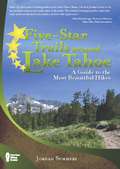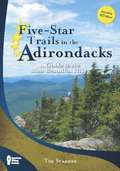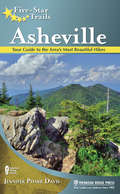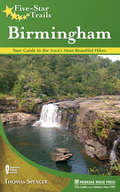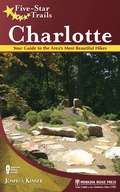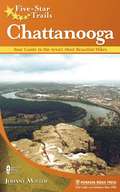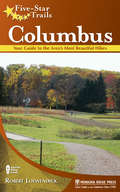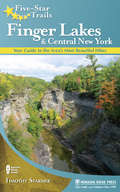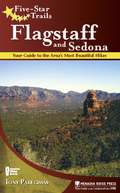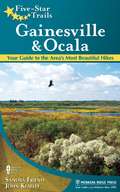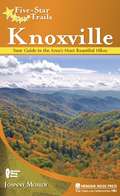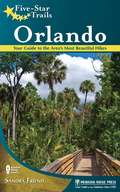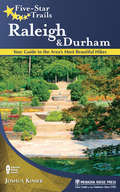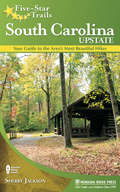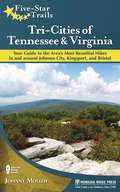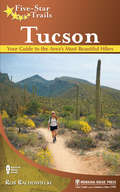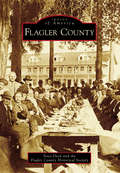- Table View
- List View
Five Nights in Paris: After Dark in the City of Light
by John BaxterAn irresistible nighttime tour of Paris, past and present, by the bestselling author of The Most Beautiful Walk in the WorldEvery guidebook to Paris is crammed with sites to see during the day, but visitors are often cast adrift once the sun sets and the Louvre, Notre Dame, and other tourist attractions shut their doors. Sadly for those who have retreated into their hotel rooms, it's only when darkness falls that the City of Light shines brightest. Full of as many unexpected detours and delightful digressions as the city itself, award-winning author John Baxter's Five Nights in Paris is the ultimate off-the-beaten-path guide to exploring the French capital after hours.Baxter leads readers on five evening tours across Paris's great neighborhoods. Each night's itinerary is selected for its connection to one of the five senses: the first, "Sound," explores the great jazz clubs of Saint-Germain-des-Prés; "Taste" samples the eclectic restaurants and bakeries of the Marais; "Touch" brings alive the city's legendary cabaret scene, including Montmartre's nearby Moulin Rouge; "Smell" describes Parisians' love of perfume and takes us to the infamous former opium fumeries along the Bois de Boulogne; and "Sight" traces the favorite haunts of the Surrealist artists, beginning in Montparnasse.
Five Seasons in Seoul: A life-changing year in South Korea
by Christine NewellChristine thought a year in South Korea would hit the pause button on her messy life. Her dad's death had left her anxious and depressed, and her career in musical theatre had reached a new low of shopping-centre kids' shows. When she found herself pulled over by the side of the road, dressed as a dinosaur and sobbing uncontrollably, it was clear something had to change.A role with an experimental theatre company based in Seoul seemed the perfect way to put off dealing with her problems, at least for a year. But she soon found there's no running away from yourself. Travelling through South Korea, immersing herself in its culture and shifting her mindset along with the seasons, Christine discovered that sometimes the place you go to escape your life can hold the answers for how to heal it.A heartfelt, sumptuous journey through one of the most fascinating cultures and landscapes on the planet, Five Seasons in Seoul is for armchair travellers and memoir lovers alike.
Five Seasons in Seoul: A life-changing year in South Korea
by Christine NewellChristine thought a year in South Korea would hit the pause button on her messy life. Her dad's death had left her anxious and depressed, and her career in musical theatre had reached a new low of shopping-centre kids' shows. When she found herself pulled over by the side of the road, dressed as a dinosaur and sobbing uncontrollably, it was clear something had to change. A role with an experimental theatre company based in Seoul seemed the perfect way to put off dealing with her problems, at least for a year. But she soon found there's no running away from yourself. Travelling through South Korea, immersing herself in its culture and shifting her mindset along with the seasons, Christine discovered that sometimes the place you go to escape your life can hold the answers for how to heal it. A heartfelt, sumptuous journey through one of the most fascinating cultures and landscapes on the planet, Five Seasons in Seoul is for armchair travellers and memoir lovers alike.
Five Years on a Rock
by Milton MurayamaMilton Murayama returns to the places and people of his earlier fiction--to the sugar plantation company towns and sleepy villages of Maui, and to the resilient Oyama family. Five Years on a Rock is the story of Sawa Oyama, the mother who plays a major role in All I Asking for Is My Body. In a spirited voice full of courage and wit, Sawa tells of her arrival in Hawaii in 1915 as a seventeen-year-old picture bride. But her hope of returning to Japan after "five years on a rock" wanes as the five years stretch to twenty, during which six children are born, her husband's fishing business succeeds then fails, and the family debt grows. Overworked and sick with worry, Sawa loses all her teeth and falls deathly ill, the victim, she believes, of someone else's bachi (divine retribution). She recovers, however, when an aunt dies in her stead, and she returns to her family with renewed vigor and a new set of teeth.
Five-Finger Discount: A Crooked Family History
by Helene Stapinski'The night my grandfather tried to kill us, I was five years old, the age I stopped believing in Santa Claus . . . ' Helene Stapinski had been playing in the family's apartment above the Majestic Tavern in Jersey City when, in the bar downstairs, Grandpa - an ex-con and armed robber - pointed his loaded gun and bragged he had a bullet for each of them. But news travelled fast and within minutes Helene was watching a handcuffed Grandpa go to jail for the last time. The Stapinski's have a knack for breaking the law. Helene's daily bread was stolen by her father from the cold storage company where he worked and the books on her shelves were swiped from the local bookbinding company. In her own generation, her first cousin embezzled a quarter of a million dollars, tearing the clan apart. All these stories are part of Helene's unbelievable heritage and of FIVE FINGER DISCOUNT, a raucous and heartbreaking tale.
Five-Star Trails around Lake Tahoe
by Jordan SummersCovering the region surrounding the 22-mile long lake, author Jordan Summers guides hikers along 40 of the region's best trails - all located within 25 miles of Lake Tahoe's shoreline.Trekkers can easily find the perfect hike with the complete trail descriptions for 27 dayhike and 13 overnight destinations. An accurate map, directions to the trailhead with coordinates for GPS use, and an elevation profile of each trail prepare hikers with the full picture of the route ahead.Generally intended for outdoors-people of all ages and abilities, Five-Star Trails around Lake Tahoe describes great hikes from the Desolation, Mt. Rose, Granite Chief, and Mokelumne Wilderness areas and along sections of the Pacific Crest National Scenic Trail and portions of the Tahoe Rim Trail. While ranging across forest- and granite-covered terrain to over a dozen peaks and several dozen lakes, hike profiles include details on natural history, geologic features, and places of historic note.With Five-Star Trails around Lake Tahoe, hikers will follow in the footsteps of pioneers such as Kit Carson and the historic Donner Party along the Pony Express Trail and the Emigrant Trail, often with stunning vistas of Lake Tahoe, Emerald Bay, Fallen Leaf Lake, or the Crystal Range.
Five-Star Trails in the Adirondacks
by Timothy StarmerEach hike through the Adirondack Park is rated for scenery, difficulty, trail condition, and accessibility for children. Individual trail maps, elevation profiles, and GPS trailhead coordinates aid in navigating the myriad of unnamed roads. Featured trails range from easy strolls for the family to bone-crunching vertical ascents for the fearless hiker.
Five-Star Trails: Ann Arbor and Detroit
by Greg TaskerEach hike features an individual trail map, elevation profile, and at-a-glance information, helping readers quickly find the perfect trip. Sized to fit in a pocket, the book's detailed trail descriptions will help readers find their way on and off the trail. Driving directions and GPS trailhead coordinates will help with navigating the myriad of unnamed roads. The trails covered range from those best suited to the novice, families, experienced hikers, or backpackers.
Five-Star Trails: Asheville
by Jennifer Pharr DavisFive-Star Trails Asheville provides in-depth trails descriptions, directions, and commentary on what to expect along the way. Each hike features an individual trail map, elevation profile, and at-a-glance information, helping readers quickly find the perfect trip.Sized to fit in a pocket, the book's detailed trail descriptions will help readers find their way on and off the trail. Driving directions and GPS trailhead coordinates will help with navigating the myriad of unnamed roads. The trails covered range from those best suited to the novice, families, experienced hikers, or backpackers.
Five-Star Trails: Birmingham
by Thomas M. SpencerIn the first decade of the 21st century, Birmingham is building again on its natural resources, but this time it's not to fire steel-making smokestacks. Instead, where railroads ran and mines once burrowed into mountains, the healed landscape is being repurposed for hiking and biking. New and expanding venues around the city are providing more opportunities not only to get outside and exercise but also to appreciate the labor and industry that built the city.In Five-Star Trails: Birmingham local author Thomas Spencer leads readers to some of the best hikes around the city. Within a short drive from Birmingham, you can find yourself on an Appalachian mountain peak or on the banks of the Cahaba River as it broadens to snake through the Coastal Plain. You can visit old growth forest in the Sipsey Wilderness or hike down into the "Grand Canyon of the East" at Little River Canyon. And that's only the start. Across this landscape, you'll find a level of diversity of plant and animal species, some rare and endangered, that rivals anywhere in the North America.
Five-Star Trails: Charlotte
by Joshua KinserFive-Star Trails: Charlotte is a handy guide for area residents, vacationers seeking outdoor fun, and for business travelers with a free afternoon. With a diverse collection of hiking routes, the book offers choices for everyone from solo trekkers to companions to families with either youngsters or oldsters to consider.Researched, experienced, and written by a local author, the guide provides in-depth trail descriptions, directions, and commentary on what to expect along the way. Each hike features an individual trail map, elevation profile, and at-a-glance key info, helping readers quickly determine the perfect trip for them when they are ready to head out the door.Sized to fit in a pocket, the book is convenient to keep in the car or toss into a backpack. Driving directions direct hikers to the nearest trailhead parking areas, and GPS trailhead coordinates get them to the start of the trail.
Five-Star Trails: Chattanooga
by Johnny MolloyFive-Star Trails: Chattanooga is a handy guide for area residents, vacationers seeking outdoor fun, and for business travelers with a free afternoon. With a diverse collection of hiking routes, the book offers choices for everyone from solo trekkers to companions to families with either youngsters or oldsters to consider.This book profiles close-in urban and suburban locations that can satiate scenery-hungry residents and also offers routes of superlative beauty in the adjacent local, state, and national parks. All this adds up to a hiker's nirvana.Chattanooga is ideally situated to enjoy some of the Southeast's best scenery. To the east and south are two huge tracts of sublime and primitive national forest land -- the Chattahoochee and the Cherokee -- much within an easy drive of Chattanooga. The national forests also offer camping, hunting, fishing, nature study, and more. To the west rises the Cumberland Plateau, with its finest features protected under the umbrella of Tennessee's state park system, centered by the Volunteer State's master path, the Cumberland Plateau. The geologically fascinating Cumberland offers hiking routes along rushing rivers, deep gorges, wild waterfalls, and other rock features.Other parks lie within the bounds of Alabama and Georgia, from Little River Canyon to Cloudland Canyon to Chickamauga Battlefield. Lookout Mountain and other local hiking destinations only add to the possibilities. The wide variety of trails, distances, difficulties, and destinations will suit any hiker's mood and company.Researched, experienced, and written by a local author, the guide provides in-depth trail descriptions, directions, and commentary on what to expect along the way. Each hike features an individual trail map, elevation profile, and at-a-glance key info, helping readers quickly determine the perfect trip for them when they are ready to head out the door.Sized to fit in a pocket, the book is convenient to keep in the car or toss into a backpack. Driving directions direct hikers to the nearest trailhead parking areas, and GPS trailhead coordinates get them to the start of the trail.
Five-Star Trails: Columbus
by Robert LoewendickFive-Star Trails: Columbus is the most current and comprehensive guide to hiking the area and rates hikes on the following factors: scenery, trail condition, difficulty, appropriateness for children, and solitude. Each hikes also includes detailed landmarks, flora, fauna, and local history. In this Columbus guide, an impressive collection of routes ranges north, east, south, and west from the metro center, as well as within the urban setting. This capital city is rich in metro parks, natural areas and preserves, state parks, and state forests. And this diversity of hiking terrain invites all levels of abilities and skills. Thus, this guidebook is geared not only to avid trekkers seeking more challenge than a paved neighborhood path, but also to families and senior citizens. Outdoor enthusiasts of every stripe will have reason to grab this book and, well, take a hike. Sized for easy carrying or tossing into a backpack, this handy guide will quickly become a treasured resource among Columbus locals and visitors alike.
Five-Star Trails: Finger Lakes and Central New York
by Timothy StarmerThe Finger Lakes and Central New York are not known for rugged mountains and their panoramic vistas which are so commonly sought in the Adirondacks to the north. They hardly could be - the area was scoured clean by glaciers millennia ago. But don't let that fool you, the region is full of natural wonders of its own. Instead of mountains and ridges, the region is known for rolling drumlins, an abundance of scenic gorges, quiet woodlands, beautiful waterfalls and picturesque lakes. The trails included in Five-Star Trails: New York's Finger Lakes and Central Region feature a broad mixture of these landscapes and were carefully selected to give the most varied but also rewarding experience when picking a trail.An assortment of state parks, local parks, state forests, conservancy areas, wildlife preserves, and nature centers riddle the region, and choice selections from each means you can find a trail that suits your preference for how civil or wild you might desire. Trails for all experience levels are included and provide opportunities for adventure for novice and expert alike.Some of these trails are well known and their inclusion in this new guide is no surprise. However far more are lesser known and a little more off the beaten path. Though these trails are not hard to find they are hard to find any real details about. What should you expect along the trail? Is the terrain rough? Will there be interesting things along the trip? Is the trail appropriate and/or safe for children? Well that lack of information is no longer an issue.Each trail has been thoroughly researched, recently hiked and includes a detailed description, trail profiles and map. At a glance ratings in important categories such as Scenery, Trail Condition, Difficulty, Solitude and appropriateness for children let you quickly select a trail that fits your tastes and ability. Other useful information such as fees, restrictions for dogs on the trail as well as advice on when to visit offers you the best information so you can plan your trip with ease. Sized to fit in a pocket, this guide is convenient to keep in the car or toss into a backpack. Driving directions direct hikers to the nearest trailhead parking areas, and GPS trailhead coordinates get them to the start of the trail.
Five-Star Trails: Flagstaff and Sedona
by Tony PadegimasEach hike features an individual trail map, elevation profile, and at-a-glance information, helping readers quickly find the perfect trip. Sized to fit in a pocket, the book's detailed trail descriptions will help readers find their way on and off the trail. Driving directions and GPS trailhead coordinates will help with navigating the myriad of unnamed roads. The trails covered range from those best suited to the novice, families, experienced hikers, or backpackers.
Five-Star Trails: Gainesville & Ocala
by John Keatley Sandra FriendWhile polar opposites in many ways - hip college town versus retiree mecca - both Gainesville and Ocala, only 35 miles apart, share a love of the outdoors. Student clubs from the University of Florida hike the same trails as Volksmarch groups from the Villages, enjoying wilderness immersion in the Ocala National Forest and scrambles on rugged terrain along the Cross Florida Greenway. With several hundred miles of trails throughout the region to choose from, Five-Star Trails: Gainesville & Ocala helps you find the best. Authored by Florida hiking expert and long-time Ocala resident Sandra Friend, with 40-year Eagle Scout and Florida Trail Association life member John Keatley, this handy guide provides a fresh perspective on the region's ever-expanding array of hiking trails. Find urban places for reflection like Sholom Park, a carefully manicured woodlands in a retirement community, and Bivens Arm Nature Park, surrounding a marsh in Gainesville; both feature inspirational quotes and places to relax along their trails. Explore the vast longleaf pine flatwoods of the Ocala National Forest on the Florida Trail near Lake Delancy and the shady swamp forests of Goethe State Forest along the Big Cypress Trail. See more alligators than you've ever seen in your life in the home of the Gators along the La Chua Trail at Paynes Prairie Preserve State Park. Covering more than 35 hikes across a three-county region, all within an hour's drive of either city, Five-Star Trails: Gainesville & Ocala gives you a reason to get outdoors now.Hikes are rated and highlighted according to their strengths from five perspectives: scenery, trail conditions, good for children, difficulty, and solitude. Author recommendations for best hikes in other categories - including wildlife watching, ancient trees, Florida Trail segments, geology, kid-friendly, and dog-friendly hikes - make it easy to choose an adventure at a glance. Add in Sandra Friend's extensive knowledge of habitats, wildlife, wildflowers, and local history, and you'll be glad to have Five-Star Trails: Gainesville & Ocala as your guide to exploring the region's outdoors.
Five-Star Trails: Knoxville
by Johnny MolloyLike others in the Five-Star Trails series, this book features up to 40 day-hikes, ranging from 1 mile to 12 miles, in and near a midsize city-in this case, Knoxville.The author has carefully chosen each hike to create a collection of routes suitable for a varied, but primarily local, outdoors audience. Based on the author's extensive and intimate knowledge of the region, some of the hikes represent a combination of two or more trails that create a unique route.As a distinguishing feature of the series, as signaled by the Five-Star series title, each entry displays ratings of one to five stars in five categories for that hike. Those categories are: Scenery Level of Difficulty Trail Conditions Degree of Solitude Appropriateness for ChildrenThe book's overview map provides a quick visual summation of the hikes' locations within the greater Knoxville area. Then, individually, each hike features an easy-to-follow trail map, elevation profile, at-a-glance information, and narrative description. The main text for each entry provides details about the route to follow. It also focuses on the most notable aspects of that route: for some, it may be the panoramic view; for others, a bit of local history
Five-Star Trails: Louisville and Southern Indiana
by Valerie AskrenKnown as the City of Parks, Louisville has long valued the natural landscape and the provisioning of outdoor recreation. In 1891 Frederick Law Olmsted, the father of American landscape architecture, was commissioned to develop an extensive park system for Louisville that eventually included 18 parks and 6 interconnecting parkways. Since that time, Louisville has continued to invest resources to build a first-class park system. Nestled within the Ohio Valley, and bordered by the knobs region to the south and the heavily forested areas of Indiana to the north, Louisville lies at the heart of an endless array of hiking opportunities.Five-Star Trails: Louisville showcases many of the hiking trails and walking paths within the city or within easy driving distance in central Kentucky and southern Indiana. Designed specifically for day trips, this book includes several of the area's most popular parks, as well as many of the lesser-known hiking trails in nature preserves, wildlife management areas, and national forests.
Five-Star Trails: Orlando
by Sandra FriendFive-Star Trails: Orlando is a handy guide for area residents, vacationers seeking outdoor fun, and for business travelers with a free afternoon. With a diverse collection of hiking routes, the book offers choices for everyone from solo trekkers to companions to families with either youngsters or oldsters to consider.Researched, experienced, and written by a local author, the guide provides in-depth trail descriptions, directions, and commentary on what to expect along the way. Each hike features an individual trail map, elevation profile, and at-a-glance key info, helping readers quickly determine the perfect trip for them when they are ready to head out the door.Sized to fit in a pocket, the book is convenient to keep in the car or toss into a backpack. Driving directions direct hikers to the nearest trailhead parking areas, and GPS trailhead coordinates get them to the start of the trail.
Five-Star Trails: Raleigh and Durham
by Joshua KinserFive-Star Trails: Raleigh and Durham is a guide to the best day-hiking trails within a two-hour drive of the urban areas of Raleigh and Durham. Raleigh is North Carolina's capital and an anchor for the state's famous Research Triangle that includes Durham and Chapel Hill. Amid this metropolitan complex that also embraces Cary, Apex, and Wake Forest-home to more than 1.7 million people-the author leads readers to myriad places for scenic beauty, to sites of historic significance, and to neighborhoods that showcase the charms of urban life. All of the routes stay true to the book's "Five-Star Trails" title, based on the book series' rating system for scenery, trail condition, suitability for children, difficulty level, and solitude. To be selected for the book, each trail must truly shine in one or more of those areas while, at the same time, all of the trails combine to offer diversity for a wide range of hikers. Thus, this is the guidebook for a hiker seeking an arduous climb to a scenic overlook as much as it is for a weekend walker who wants an easy trail for his or her family.
Five-Star Trails: South Carolina Upstate
by Sherry JacksonThe South Carolina Upcountry is gaining more popularity and people visiting will need to know how to discover all it has to offer. Outdoor activities here abound and there are a good variety of trails for hikers of all levels. From waterfalls to amazing mountain views, each trail offers hikers an incredible experience. Since the Upcountry is relatively "undiscovered", there are very few books that have a true compilation of hikes in the area. Five-Star Trails: South Carolina Upstate will bring together those hiking trails that offer a "five star" experience.Each trail has been thoroughly researched, recently hiked and includes a detailed description, trail profiles and map. At a glance ratings in important categories such as Scenery, Trail Condition, Difficulty, Solitude and appropriateness for children let you quickly select a trail that fits your tastes and ability. Other useful information such as fees, restrictions for dogs on the trail as well as advice on when to visit offers you the best information so you can plan your trip with ease. Five-Star Trails: South Carolina Upstate provides directions and commentary for each trail on what to expect along the way, making it more than just an average guidebook. This guide will lead hikers off the beaten path to find exceptional beauty as well as peace of mind. The diversity in terrain invites all levels of abilities and skills. Outdoor enthusiasts of every level will have reason to grab this guide and take a hike.This book offers easy-to-moderate trails that are within driving distance from a reader's workplace or home in the South Carolina Upstate. Without this book, they might miss the hidden hiking treasures of the area, but with the expert help of Sherry Jackson, readers will enjoy the region's best trails!
Five-Star Trails: Tri-Cities of Tennessee and Virginia
by Johnny MolloyFive-Star Trails: Tri-Cities of Tennessee and Virginia details the 40 best hikes in and around Johnson City, Kingsport, and Bristol as well as the surrounding areas of Abingdon, Elizabethton, Greenville, and Rogersville. Drawing from a wealth of trails on vast public lands, the mosaic of hikes featured reflects the wide variety of terrain in the greater Tri-Cities, from high mountains to the east and south to the historic walks in Tennessee state parks. The Appalachian Trail also provides nearly 70 miles of quality hiking around the Tri-Cities. Authored by Johnny Molloy, the most experienced guidebook author in the field today, this guide has something for everyone, from a leisurely weekend stroll to advanced treks into the Appalachians.
Five-Star Trails: Tucson
by Rob RachowieckiTucson lies in a saguaro-studded desert basin surrounded by four mountain ranges and book-ended by two national parks. In an hour you can drive from an arid canyon in the Arizona-Sonora desert to a pine-forested mountain at 9000 feet. Hiking trails are plentiful and as varied as the terrain. Five-Star Trails: Tucson by Rob Rachowiecki guides you to diverse hikes suitable for anyone from wheelchair-using nature lovers to hikers looking for an all-day workout.Each trail has been thoroughly researched, recently hiked and includes a detailed description, trail profiles and map. At a glance categorical ratings, such as Scenery, Trail Condition, Difficulty, Solitude and kid-friendliness, let you quickly select a trail that fits your tastes and ability. Other key information such as fees, restrictions for dogs on the trail as well as advice on when to visit offers you the best information so you can plan your trip with ease.Sized to fit in a pocket, this guide is convenient to keep in the car or toss into a backpack. Driving directions direct hikers to the nearest trailhead parking areas, and GPS trailhead coordinates get them to the start of the trail.
Fixing Motorcycles in Post-Repair Societies: Technology, Aesthetics and Gender (Politics of Repair #3)
by Gabriel JderuMost social science studies on automobility have focused on the production, usage, identity construction and aesthetic improvements of personal means of transportation. What happens if we shift the focus to the labour, knowledge and social relations that go into the unavoidable moments of maintenance and repair? Taking motorcycling in Romania as an ethnographic entry point, this book documents how bikers handle the inevitable moments of malfunction and breakdown. Using both mobile and sedentary research methods, the book describes the joys and troubles experienced by amateur mechanics, professional mechanics and untechnical men and women when fixing bikes.
Flagler County (Images of America)
by Sisco Deen The Flagler County Historical SocietyFlagler County was created in 1917 from portions of southern St. Johns County and northern Volusia County. The county was named after Henry Morrison Flagler, a railroad and oil tycoon, who was a developer of the Florida East Coast Railway during the 1880s and 1900s. Bunnell, located 30 miles south of St. Augustine, was established as the county seat. Joseph Marion Hernandez, the first Hispanic to serve in the US Congress, had three successful sugar plantations in Flagler County until they were burned down by Native Americans in 1836, during the Second Seminole War. Marine Studios, later named Marineland, opened in 1938 as the world�s first underwater motion picture studio. The economic driving force in the county until the early 1970s was its agriculture and forestry industry. In the late 1960s, International Telephone and Telegraph Corporation (ITT) purchased 22,000 acres of timberland and established the retirement community of Palm Coast. Today, the county thrives upon successful real estate and service industries.




